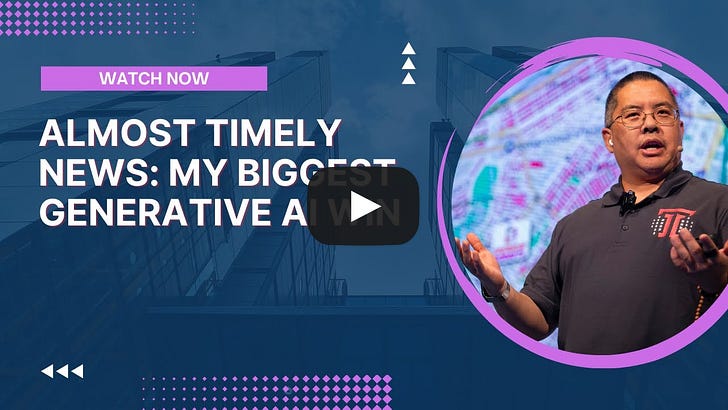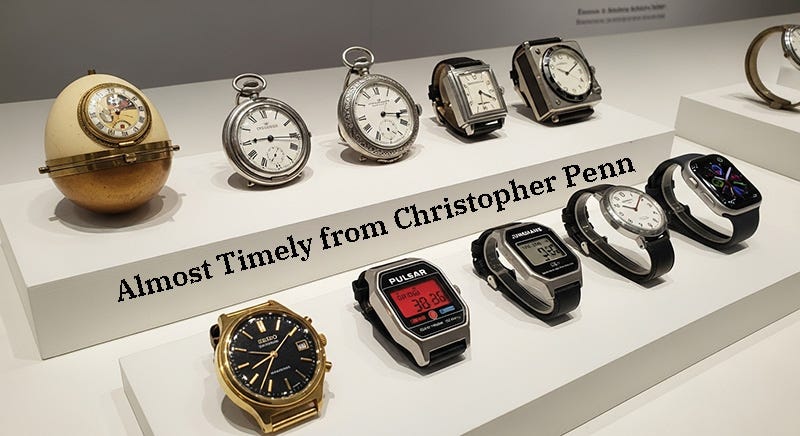|
Almost Timely News: 🗞️ My Biggest Generative AI Win (2025-06-29) :: View in Browser
The Big Plug
👉 My new book, Almost Timeless: 48 Foundation Principles of Generative AI is now available!
Content Authenticity Statement
100% of this week's newsletter was generated by me, the human. You will see bountiful AI outputs in the video. Learn why this kind of disclosure is a good idea and might be required for anyone doing business in any capacity with the EU in the near future.
Watch This Newsletter On YouTube 📺

Click here for the video 📺 version of this newsletter on YouTube »
Click here for an MP3 audio 🎧 only version »
What's On My Mind: My Biggest Generative AI Win
This past week, as part of my promotional tour for my new book, Almost Timeless: 48 Foundation Principles of Generative AI, I hit the podcast circuit. One of the questions I was asked was fascinating to think about, and in the moment, the answer I gave was correct but not thorough, so we'll remediate that today.
The question was: what's your biggest win with generative AI?
Generative AI is so incredibly capable of so many tasks across so many domains that it's often difficult to think of any one singular thing that represents a massive win, but in the heat of the moment, the first thing that sprang to mind was software development.
Why? Because generative AI is absolutely superb at the act of generating software. It can program in any major coding language, and today's models are so incredibly smart that they can pretty much accomplish anything you tell them to.
However, they're also prone to tons of mistakes, of going off the rails, of getting caught in endless loops. So today, let's talk through HOW I use generative AI to construct software.
Now, before we continue, you might say, but Chris, I'm not a software developer. I'm not a coder. I don't know how to code.
Neither do I, not really. I'm a pretty crap coder. I'm mediocre, mid at best on a good day. But I am a fabulous question asker and a solid thinker. I know enough of the lingo to prompt generative AI well, and I have generally good ideas. That combination of attributes is, to me, the best combination for AI + humans: AI brings the manual labor, I bring the ideas and direction. In a lot of ways, it's management and delegation. I'm not doing the typing, but I am absolutely managing the project.
So let's dig into how I do this, and perhaps you'll pick up some things you can use yourself. If you want to try this out and you don't want to install things yourself, you can always copy and paste your code into a free environment like Google Colab.
Part 1: The 5Ps
Everything begins with Katie Robbert's fantastic Trust Insights 5P Framework:
Purpose: why are we building this software?
People: who is going to use it and what are their needs and limitations?
Process: how are we going to build it?
Platform: what language and toolings are we building it in?
Performance: how do we know we succeeded?
Let's pick a toy example for today, something we can easily put together as a simple example. Let's say I want to take an export of my YouTube videos from my channel and categorize them, then make a viewer's guide of videos, like a cheat sheet of my content. That's a fairly straightforward task save for one thing: I have hundreds of videos on my channel, which means that I can't just copy paste the entire thing into a generative AI tool and have it spit out a clean result.
Especially if I want to group things and categorize them, make them neat and orderly. So I could export the raw list of data from my YouTube channel, and then we need to create some code to process it, make decisions about how to classify my videos, and ultimately spit out a nice looking guide that I can share with you as a form of bonus content.
I'd determine the purpose with the creation of a user story, something like this:
As a content creator on YouTube, I need to create a cheat sheet of categorized YouTube videos since January 2024 so that my viewers can find exactly the videos they want to see quickly.
User stories fit in the format of "As a {role}, I need to {task} so that {outcome}" - a very handy way to pick apart many of the requirements for our project. You can learn a lot more about this in Katie's AI-Ready Marketing Strategy Kit, free of charge (form fill required) here. It's not a stretch at all to say that almost all of what I've learned about great planning over the last 10 years, I've learned from her.
The people are pretty clear: you, my audience. I want you to find exactly what you're looking for quickly.
The process... is what we're doing. Broadly, my software needs to ingest a CSV file, infer the correct YouTube URLs, classify the videos by the topic using fuzzy keyword matching in a set of topics we have to determine with generative AI, and then produce a nice guide in HTML and CSS of my videos, organized by topic, by date in descending order, with the video titles all linked back to the source videos.
The platform is going to be Python to generate the outcome. The outcome itself will be simple, styled HTML that looks nice. I choose Python, not because I love it (I really don't, I'm old and prefer more C-like languages), but because it's the language that generative AI speaks the absolute best. I might also specify additional key details like the software must be completely self contained and rely on no external APIs or services. It must operate without an Internet connection of any kind.
And the performance is a working piece of software, free of bugs, that successfully generates the cheat sheet.
Here's the secret of Katie's 5P framework: it dramatically shortens requirements gathering because we just did about 75% of it.
Part 2: Best Practices and Coding Standards
Okay, so we've gotten our 5Ps done. Next, we need coding standards and best practices. You can't - well, you shouldn't - just go to your favorite generative AI tool and say, "Hey, let's code this thing!". That will result in code spaghetti, massive technical debt, and... well, flat out disaster.
Instead, we want to use generative AI's deep research tools - available in pretty much every platform - to build us a best practices guide, starting information that we'll use with generative AI to build our code and guide us in the process.
Here's an example prompt that we would use, based on the 5Ps we just did.
I need to construct a best practices guide for Python 3.11 to accomplish building this software. The guide should contain best practices for Python 3.11 for the specific purpose of the software, should include lists of libraries and packages and their current versions that would make development of the software easy and fast, should rely solely on free, open source software (FOSS), and should contain code samples and examples. It's 2025-06-28; prefer sources from 2024-2025.
I then copy and paste the 5Ps from above as the second half of the prompt and feed it to my deep research tool.
Let the deep research tool assemble the custom best practices guide, which will take anywhere from 5 to 50 minutes depending on the tool you use.
Why do this? Because every project is different, and we want to leverage the knowledge out there that deep research tools can assemble specific to this use case. While having general, global coding standards is good, having coding standards that fit the specific project can be beneficial - especially when the deep research tools surface things like packages and libraries that you didn't even know exist.
You can see an example of the coding standards for this project in the video version of the newsletter, as it's quite extensive.
Part 3: Requirements Gathering
We have our 5P framework and our coding standards and best practices. It's now time to do requirements gathering. The outcome of this stage is something calle a product requirements document, or a PRD. This is something software development teams use as the guidebook or rules for a project, and contains everything that the project should have.
